

The Media Capture and Streams API (aka MediaStream API) allows you to record audio from a user’s microphone, then get the recorded audio or media elements as tracks. You can then either play these tracks straight after recording them, or upload the media to your server.
In this tutorial, we’ll create a website that will use the Media Streams API to allow the user to record something, then upload the recorded audio to the server to be saved. The user will also be able to see and play all the uploaded recordings.
You can find the full code for this tutorial in this GitHub Repository.
Setting Up The Server
We’ll first start by creating a Node.js and Express server. So firstly make sure to download and install Node.js if you don’t have it on your machine.
Create a directory
Create a new directory that will hold the project, and change to that directory:
mkdir recording-tutorial
cd recording-tutorial
Initialize the project
Then, initialize the project with npm:
npm init -y
The option -y creates package.json with the default values.
Install the dependencies
Next, we’ll install Express for the server we’re creating and nodemon to restart the server when there are any changes:
npm i express nodemon
Create the Express server
We can start now by creating a simple server. Create index.js in the root of the project with the following content:
const path = require('path');
const express = require('express');
const app = express();
const port = process.env.PORT || 3000;
app.use(express.static('public/assets'));
app.listen(port, () => `);
});
This creates a server that will run on port 3000 unless a port is set in the environment, and it exposes a directory public/assets — which we’ll create soon — that will hold JavaScript and CSS files and images.
Add a script
Finally, add a start script under scripts in package.json:
"scripts": ,
Start the web server
Let’s test our server. Run the following to start the server:
npm start
And the server should start at port 3000. You can try accessing it on localhost:3000, but you’ll see a message saying “Cannot GET /” since we don’t have any routes defined yet.
Creating the Recording Page
Next, we’ll create the page that will be the main page of the website. The user will use this page to record and view and play recordings.
Create the public directory, and inside that create an index.html file with the following content:
<! html>
Record
Record Your Voice
This page uses Bootstrap 5 for styling. For now, the page just shows a button that the user can use for recording.
Note that we’re using an image for the microphone. You can download the icon on Iconscout, or you can use the modified version in the GitHub repository.
Download the icon and place it inside public/assets/images with the name microphone.png.
Adding styles
We’re also linking the stylesheet index.css, so create an public/assets/css/index.css file with the following content:
.record-button
.record-button:hover
Creating the route
Finally, we just need to add the new route in index.js. Add the following before app.listen:
app.get('/', (req, res) => );
If the server isn’t already running, start the server with npm start. Then go to localhost:3000 in your browser. You’ll see a record button.
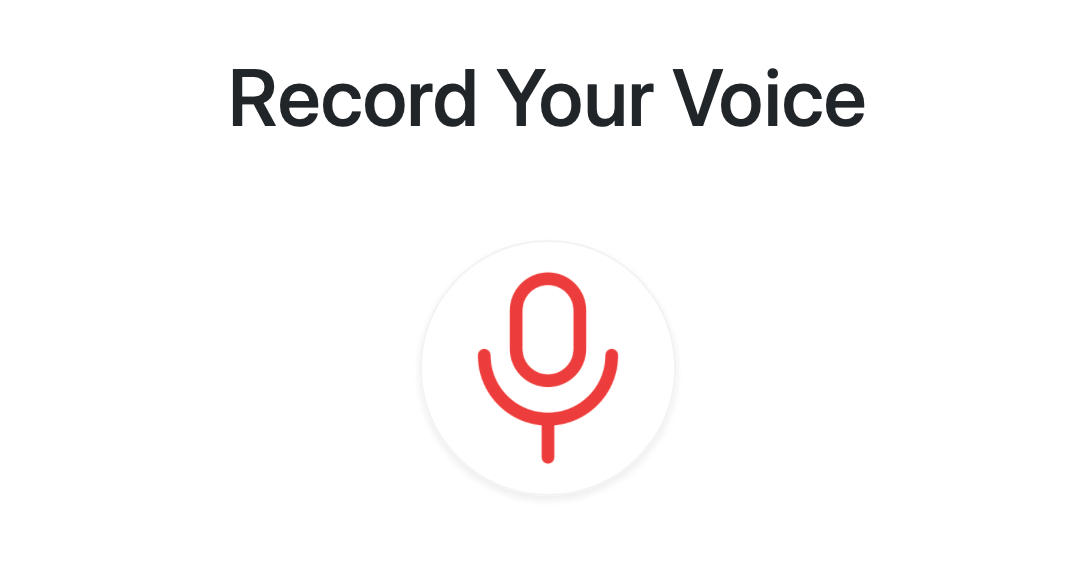
The button, for now, does nothing. We’ll need to bind a click event that will trigger the recording.
Create a public/assets/js/record.js file with the following content:
const recordButton = document.getElementById('recordButton');
const recordButtonImage = recordButton.firstElementChild;
let chunks = [];
let mediaRecorder = null;
let audioBlob = null;
We’re initializing the variables we’ll use later. Then create a record function, which will be the event listener to the click event on recordButton:
function record()
recordButton.addEventListener('click', record);
We’re also attaching this function as an event listener to the record button.
Media recording
In order to start recording, we’ll need to use the mediaDevices.getUserMedia() method.
This method allows us to obtain a stream and record the audio and/or video of the user only once the user provides permission for the website to do that. The getUserMedia method allows us to access local input devices.
getUserMedia accepts as a parameter an object of MediaStreamConstraints, which comprises a set of constraints that specify what are the expected media types in the stream we’ll obtain from getUserMedia. These constraints can be either audio and video with Boolean values.
If the value is false, it means we’re not interested in accessing this device or recording this media.
getUserMedia returns a promise. If the user allows the website to record, the promise’s fulfillment handler receives a MediaStream object which we can use to media capture video or audio streams of the user.
Media capture and streams
To use MediaStream API objects to capture media tracks, we need to use the MediaRecorder interface. We’ll need to create a new object of the interface which accepts the MediaStream object in the constructor and allows us to control the recording easily through its methods.
Inside the record function, add the following:
if (!navigator.mediaDevices || !navigator.mediaDevices.getUserMedia)
recordButtonImage.src = `/images/$.png`;
if (!mediaRecorder) )
.then((stream) => )
.catch((err) => `);
recordButtonImage.src = '/images/microphone.png';
});
} else
Browser support
We’re first checking whether navigator.mediaDevices and navigator.mediaDevices.getUserMedia are defined, since there are browsers like Internet Explorer, Chrome on Android, or others that don’t support it.
Furthermore, using getUserMedia requires secure websites, which means either a page loaded using HTTPS, file://, or from localhost. So, if the page isn’t loaded securely, mediaDevices and getUserMedia will be undefined.
Start recording
If the condition is false (that is, both mediaDevices and getUserMedia are supported), we’re first changing the image of the recording button to stop.png, which you can download from Iconscout or the GitHub repository and place it in public/assets/images.
Then, we’re checking if mediaRecorder — which we defined at the beginning of the file — is or isn’t null.
If it’s null, it means there’s no ongoing recording. So, we get a MediaStream instance to start recording using getUserMedia.
We’re passing it an object with only the key audio and value true, as we’re just recording the audio.
This is where the browser prompts the user to allow the website to access the microphone. If the user allows it, the code inside the fulfillment handler will be executed:
mediaRecorder = new MediaRecorder(stream);
mediaRecorder.start();
mediaRecorder.ondataavailable = mediaRecorderDataAvailable;
mediaRecorder.onstop = mediaRecorderStop;
Here we’re creating a new MediaRecorder, assigning it to mediaRecorder which we defined at the beginning of the file.
We’re passing the constructor the stream received from getUserMedia. Then, we’re starting the recording using mediaRecorder.start().
Finally, we’re binding event handlers (which we’ll create soon) to two events, dataavailable and stop.
We’ve also added a catch handler in case the user doesn’t allow the website to access the microphone or any other exception that might be thrown.
Stop recording
This all occurs if the mediaRecorder is not null. If it’s null, it means that there’s an ongoing recording and the user is ending it. So, we’re using the mediaRecorder.stop() method to stop the recording:
} else
Handle media recording events
Our code so far starts and stops the recording when the user clicks the record button. Next, we’ll add the event handlers for dataavailable and stop.
On data available
The dataavailable event is triggered either when a full recording is done, or based on an optional parameter timeslice being passed to mediaRecorder.start() to indicate the number of milliseconds that this event should be triggered. Passing the timeslice allows slicing the recording and obtaining it in chunks.
Create the mediaRecorderDataAvailable function, which will handle the dataavailable event just by adding the Blob audio track in the received BlobEvent parameter to the chunks array, which we defined at the beginning of the file:
function mediaRecorderDataAvailable(e)
The chunk will be an array of audio tracks of the user’s recording.
On stop
Before we create the mediaRecorderStop, which will handle the stop event, let’s first add the HTML element container that will hold the recorded audio with the buttons Save and Discard.
Add the following in public/index.html just before the closing </body> tag:
Save
Discard
Then, at the beginning of public/assets/js/record.js, add a variable that will be a Node instance of the #recordedAudioContainer element:
const recordedAudioContainer = document.getElementById('recordedAudioContainer');
We can now implement mediaRecorderStop. This function will first remove any audio element that was previously recorded and not saved, create a new audio media element, set the src to be the Blob of the recorded stream, and show the container:
function mediaRecorderStop ()
const audioElm = document.createElement('audio');
audioElm.setAttribute('controls', '');
audioBlob = new Blob(chunks, );
const audioURL = window.URL.createObjectURL(audioBlob);
audioElm.src = audioURL;
recordedAudioContainer.insertBefore(audioElm, recordedAudioContainer.firstElementChild);
recordedAudioContainer.classList.add('d-flex');
recordedAudioContainer.classList.remove('d-none');
mediaRecorder = null;
chunks = [];
}
In the end, we’re resetting mediaRecorder and chunks to their initial values to handle the next recordings. With this code, our website should be able to record the audio, and when the user stops, it allows them to play the recorded audio.
The last thing we need to do is link to record.js in index.html. Add the script at the end of the body:
Test recording
Let’s see it now. Go to localhost:3000 in your browser and click on the record button. You’ll be asked to allow the website to use the microphone.
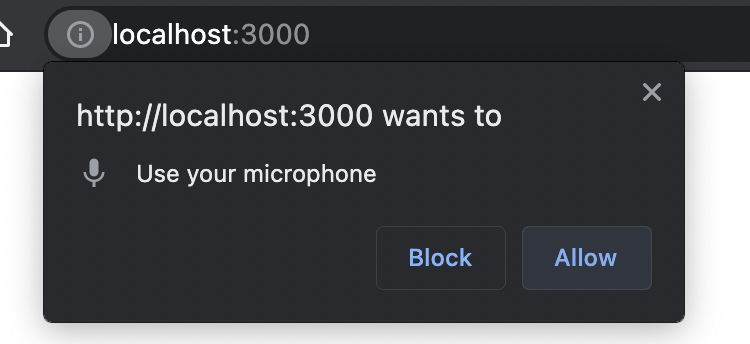
Make sure you’re loading the website either on localhost or an HTTPS server even if you’re using a supported browser. MediaDevices and getUserMedia are not available under other conditions.
Click on Allow. The microphone image will then change to the stop image. Also, you should see a recording icon in the address bar based on your browser. This indicates that the microphone is currently accessed by the website.
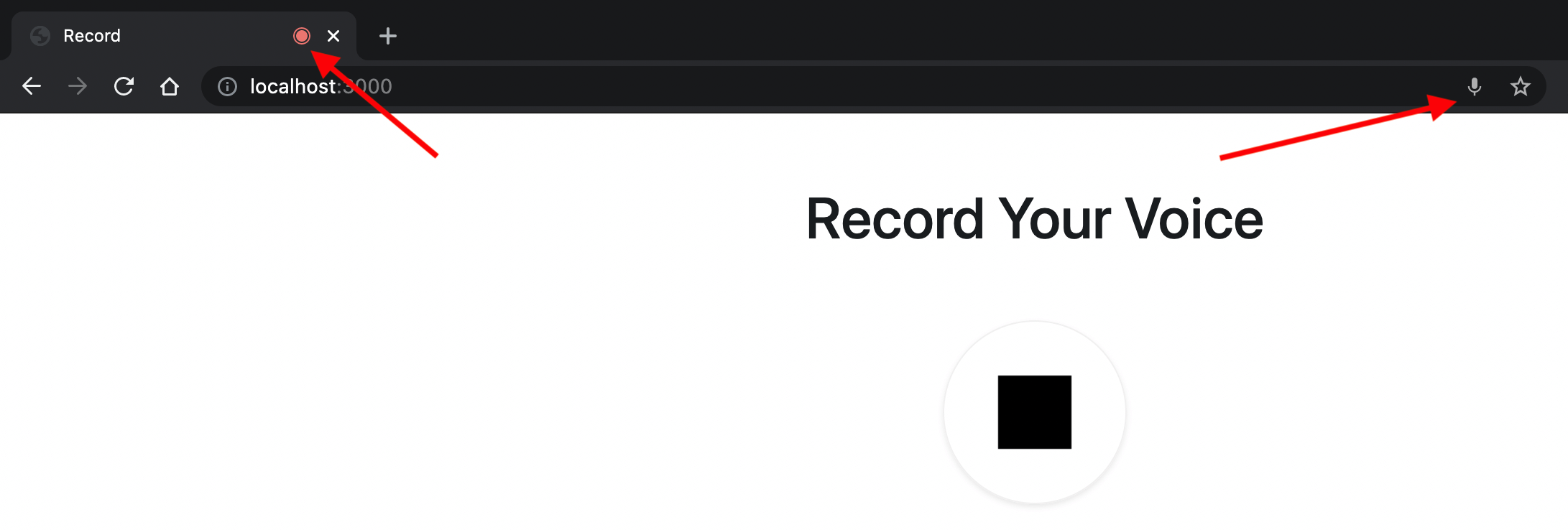
Try recording for a few seconds. Then click on the stop button. The image of the button will change back to the microphone image, and the audio player will show up with two buttons — Save and Discard.
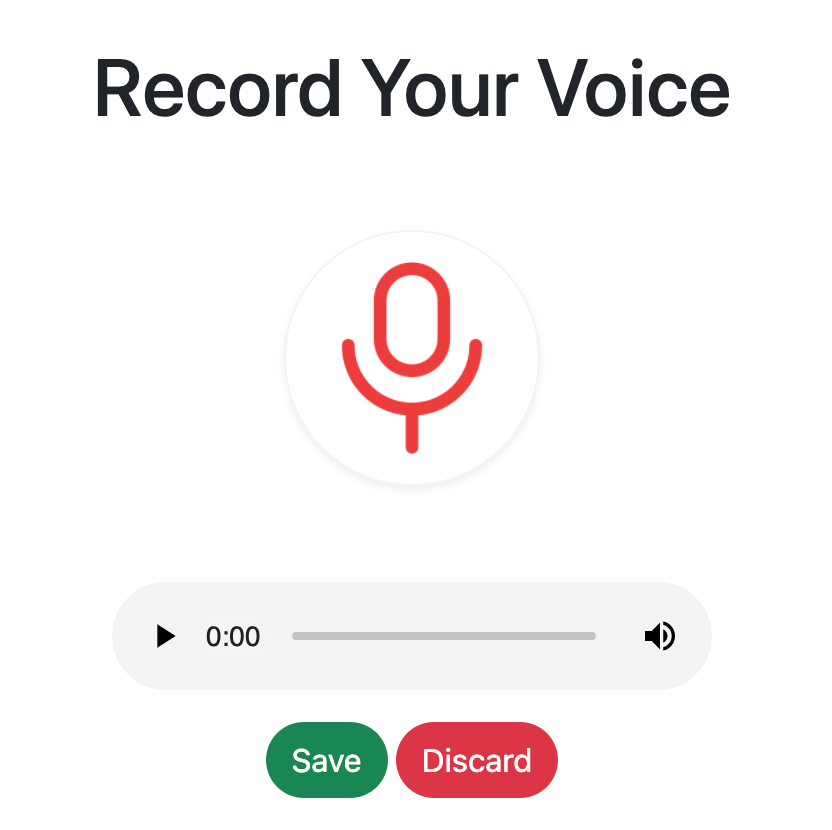
Next, we’ll implement the click events of the Save and Discard buttons. The Save button should upload the audio to the server, and the Discard button should remove it.
Discard click event handler
We’ll first implement the event handler for the Discard button. Clicking this button should first show the user a prompt to confirm that they want to discard the recording. Then, if the user confirms, it will remove the audio player and hide the buttons.
Add the variable that will hold the Discard button to the beginning of public/assets/js/record.js:
const discardAudioButton = document.getElementById('discardButton');
Then, add the following to the end of the file:
function discardRecording ()
}
function resetRecording ()
audioBlob = null;
}
discardAudioButton.addEventListener('click', discardRecording);
You can now try recording something, then clicking the Discard button. The audio player will be removed and the buttons hidden.
Upload to Server
Save click event handler
Now, we’ll implement the click handler for the Save button. This handler will upload the audioBlob to the server using the Fetch API when the user clicks the Save button.
If you’re unfamiliar with the Fetch API, you can learn more in our “Introduction to the Fetch API” tutorial.
Let’s start by creating an uploads directory in the project root:
mkdir uploads
Then, at the beginning of record.js, add a variable that will hold the Save button element:
const saveAudioButton = document.getElementById('saveButton');
Then, at the end, add the following:
function saveRecording () )
.then((response) => response.json())
.then(() => )
.catch((err) => )
}
saveAudioButton.addEventListener('click', saveRecording);
Notice that, once the recording is uploaded, we’re using resetRecording to reset the audio for the next recording. Later, we’ll fetch all the recordings to show them to the user.
Create API Endpoint
We need to implement the API endpoint now. The endpoint will upload the audio to the uploads directory.
To handle file upload easily in Express, we’ll use the library Multer. Multer provides a middleware to handle the file upload.
Run the following to install it:
npm i multer
Then, in index.js, add the following to the beginning of the file:
const fs = require('fs');
const multer = require('multer');
const storage = multer.diskStorage(,
filename(req, file, cb) .$`);
},
});
const upload = multer();
We declared storage using multer.diskStorage, which we’re configuring to store files in the uploads directory, and we’re saving the files based on the current timestamp with the extension.
Then, we declared upload, which will be the middleware that will upload files.
Next, we want to make files inside the uploads directory publicly accessible. So, add the following before app.listen:
app.use(express.static('uploads'));
Finally, we’ll create the upload endpoint. This endpoint will just use the upload middleware to upload the audio and return a JSON response:
app.post('/record', upload.single('audio'), (req, res) => res.json());
The upload middleware will handle the file upload. We just need to pass the field name of the file we’re uploading to upload.single.
Please note that, normally, you need to perform validation on files and make sure that the correct, expected file types are being uploaded. For simplicity’s sake, we’re omitting that in this tutorial.
Test upload
Let’s test it out. Go to localhost:3000 in your browser again, record something, and click the Save button.
The request will be sent to the endpoint, the file will be uploaded, and an alert will be shown to the user to inform them the recording is saved.
You can confirm that the audio is actually uploaded by checking the uploads directory at the root of your project. You should find an MP3 audio file there.
Show Recordings
Create an API endpoint
The last thing we’ll do is show all recordings to the user so they can play them.
First, we’ll create the endpoint that will be used to get all the files. Add the following before app.listen in index.js:
app.get('/recordings', (req, res) => ).map((file) => `/$`);
return res.json();
});
We’re just reading files inside the uploads directory, filtering them to get only the mp3 files, and appending a / to each file name. Finally, we’re returning a JSON object with the files.
Add a recordings container element
Next, we’ll add an HTML element that will be the container of the recordings we’ll show. Add the following at the end of the body before the record.js script:
Saved Recordings
Fetch files from the API
Also add to the beginning of record.js the variable that will hold the #recordings element:
const recordingsContainer = document.getElementById('recordings');
Then, we’ll add a fetchRecordings function that will call the endpoint we created earlier, and will then, with the createRecordingElement function, render the elements that will be the audio players.
We’ll also add a playRecording event listener for the click event on the button that will play the audio.
Add the following at the end of record.js:
function fetchRecordings () )
}
})
.catch((err) => console.error(err));
}
function createRecordingElement (file) ;
recordingElement.appendChild(audio);
const playButton = document.createElement('button');
playButton.classList.add('play-button', 'btn', 'border', 'shadow-sm', 'text-center', 'd-block', 'mx-auto');
const playImage = document.createElement('img');
playImage.src = '/images/play.png';
playImage.classList.add('img-fluid');
playButton.appendChild(playImage);
playButton.addEventListener('click', playRecording);
recordingElement.appendChild(playButton);
return recordingElement;
}
function playRecording (e)
const audio = button.previousElementSibling;
if (audio && audio.tagName === 'AUDIO') else
}
}
Notice that, inside playRecording function, we’re checking if the audio is playing using audio.paused, which will return true if the audio isn’t playing at the moment.
We’re also using play and pause icons that will show inside each recording. You can get these icons from Iconscout or the GitHub repository.
We’ll use fetchRecordings when the page loads and when a new recording has been uploaded.
So, call the function at the end of record.js and inside the fulfillment handler in saveRecording in place of the TODO comment:
.then(() => )
Adding styles
The last thing we need to do is add some styling to the elements we are creating. Add the following to public/assets/css/index.css:
.play-button:hover
.play-button
Test everything
It’s all ready now. Open the website on localhost:3000 in your browser, and if you uploaded any recordings before, you’ll see them now. You can also try uploading new ones and see the list get updated.
The user can now record their voice, save or discard them. The user can also view all uploaded recordings and play them.
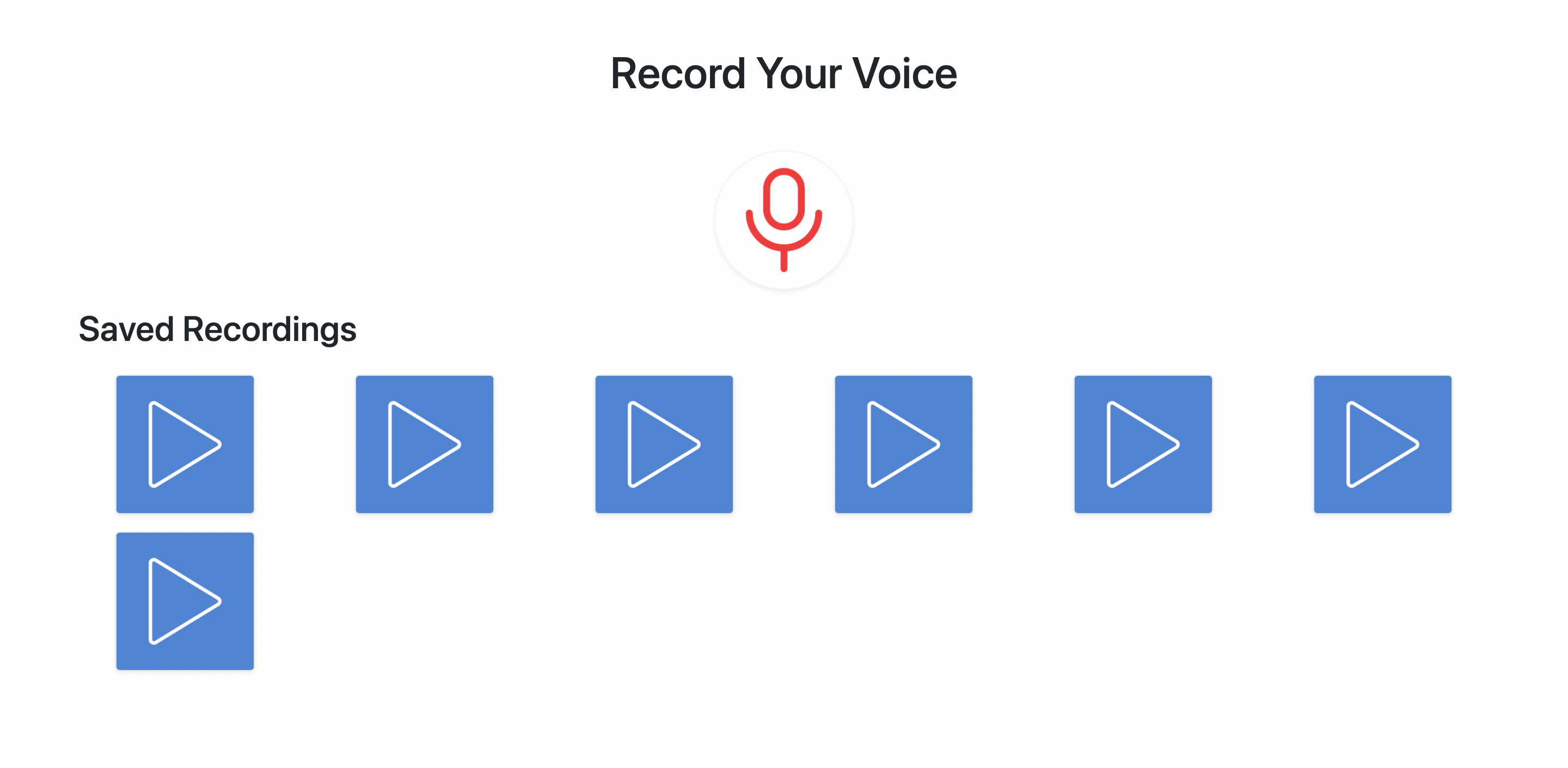
Conclusion
Using the MediaStream API allows us to add media features for the user, such as recording audio. The MediaStream Web API also allows the recording of videos, taking screenshots, and more. Following the information given in this tutorial, along with useful tutorials provided by MDN and SitePoint, you’ll be able to add the whole range of other media functionalities to your website as well.









 Add Category
Add Category